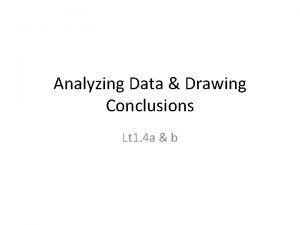Warmup Find out where you can find rand


























- Slides: 26

Warm-up: Find out where you can find rand. Int in your calculator. Write down the keystrokes.

Chapter 6 Normal Distribution

Objectives & HW: The students will be able to compare values from different distributions using their z-scores. HW: Ch 6: 2, 4, 6, 7, 8 Read p. 110 -123

Notes: Standard Deviation and the Normal Model Standard deviation is a measure of spread, or variability. The smaller the standard deviation, the less variability is present in the data. The larger the standard deviation, the more variability is present in the data.

Standard deviation can be used as a ruler for measuring how an individual compares to a group. To measure how far above or below the mean any given data value is, we find its standardized value, or z-score. To standardize a value, subtract the mean and divide by the standard deviation.

Measure your height in inches. Calculate the standardized value for your height given that the average height for women is 64. 5 inches with a standard deviation of 2. 5 inches and for men is 69 inches with a standard deviation of 2. 5 inches. Are you tall?

Suppose the average woman’s shoe size is 8. 25 with a standard deviation 1. 15 and the average male shoe size is 10 with a standard deviation of 1. 5. Do you have big feet?

Suppose Sharon wears a size 9 shoe and Andrew wears a size 9. Does Sharon have big feet? Does Andrew?

In order to compare values that are measured using different scales, you must first standardize the values. The standardized values have no units and are called z-scores. Z-scores represent how far the value is above the mean (if positive) or below the mean (if negative).

Ex: z = 1 means the value is one standard deviation above the mean z = -0. 5 means the value is one-half of a standard deviation below the mean The larger the absolute value of a z-score, the more unusual it is.

Standardized values, because they have no units, are therefore useful when comparing values that are measured on different scales, with different units, or from different populations.

Transforming Data Activity

Adding a constant to all of the values in a set of data adds the same constant to the measures of center and percentiles. It does not, however, affect the spread.

Example: Add 5 to each value in the given set of data (on the left) to form a new set of data (on the right). Then find the indicated measures of center and spread. {5, 5, 10, 35, 45}. Center: Ë= M= Mode = Spread: Range = IQR = SD = {10, 15, 40, 50}. Center: Ë= M= Mode = Spread: Range = IQR = SD =

Multiplying a constant to all of the values in a set of data multiplies the same constant to the measures of center and spread.

Example: Multiply each value in the given set of data (on the left) by 2 to form a new set of data (on the right). Then find the indicated measures of center and spread. {5, 5, 10, 35, 45}. Center: Ë= M= Mode = Spread: Range = IQR = SD = {10, 20, 70, 90}. Center: Ë= M= Mode = Spread: Range = IQR = SD =

By standardizing values, we shift the distribution so that the mean is 0, and rescale it so that the standard deviation is 1. Standardizing does not change the shape of the distribution.

The Normal model: is symmetric and bell-shaped. follows the 68 -95 -99. 7 Rule o About 68% of the values fall within one standard deviation of the mean. o About 95% of the values fall within two standard deviations of the mean. o About 99. 7% (almost all) of the values fall within three standard deviations of the mean.


The standard Normal model has mean 0 and standard deviation 1.

The Normal model is determined by sigma and mu. We use the Greek letters sigma and mu because this is a model; it does not come from actual data. Sigma and mu are the parameters that specify the model.

The larger sigma, the more spread out the normal model appears. The inflection points occur a distance of 1 sigma on either side of mu.

To standardize Normal data, subtract the mean (mu) and divide by the standard deviation (sigma).

To assess normality: Examine the shape of the histogram or stem-and-leaf plot. A normal model is symmetric about the mean and bellshaped. Compare the mean and median. In a Normal model, the mean and median are equal. Verify that the 68 -95 -99. 7 Rule holds. Construct a normal probability plot. If the graph is linear, the model is Normal.

Nearly Normal:

Skewed distribution:
 If you think you can you can poem
If you think you can you can poem Who am i riddles animals
Who am i riddles animals One direction one thing lyrics
One direction one thing lyrics If you can imagine it you can achieve it
If you can imagine it you can achieve it If we can't measure it we can't manage it
If we can't measure it we can't manage it If you can't measure it, you can't manage it
If you can't measure it, you can't manage it You can t improve what you don t measure
You can t improve what you don t measure Vermögensstruktur kennzahl
Vermögensstruktur kennzahl Warmup ratio
Warmup ratio Warmup 65
Warmup 65 Gmass warmup
Gmass warmup Stratified warmup
Stratified warmup Pyramid warmup
Pyramid warmup Identical rhyme examples
Identical rhyme examples Multiplying exponents with same base
Multiplying exponents with same base Java warmup
Java warmup Define:warmup
Define:warmup Ethos warmup
Ethos warmup Tom schwartz tinman
Tom schwartz tinman 65 mins
65 mins Warmup end
Warmup end Find out the odd one out
Find out the odd one out Matthew 11 28-30 the message
Matthew 11 28-30 the message The act of drawing conclusions from the analyzed data
The act of drawing conclusions from the analyzed data What cup can you never drink out of
What cup can you never drink out of Deoxribonucleic
Deoxribonucleic O pernuta afanata
O pernuta afanata


















































